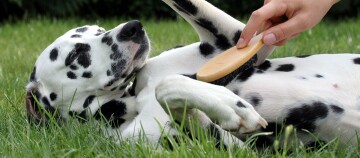Coat Shedding in Dogs - This Is How to Groom Them Correctly!
11.03.2025 - Reading time: 3 minutes

Most dogs, except for a few ancient breeds from Peru and Mexico, have a full coat covering their bodies. Just like humans change clothes regularly, dogs need to change their coats too. You'll need to have a broom, vacuum cleaner, comb, brush, or even a trimmer handy twice a year. Here’s how you can help your dog during the shedding process.
The coat
Most dogs have fur covering their entire bodies, except for their nose tips and paw pads. Hair grows in tufts from clusters invisible to us, with each main hair associated with two to three secondary hairs. The hair root lies under the skin, and sebaceous glands supply each hair with oils and minerals. Healthy hair is shiny and supple, reflecting the dog’s physical and mental well-being. Ingredients of spot-ons are distributed via the skin’s oily layer, protecting the dog from flea and tick bites.
Dogs have both a topcoat and an undercoat. Although each hair is light, the overall amount makes a difference. For short-haired dogs without an undercoat, it’s about four grams of hair per kilo of body weight; for long-haired dogs with a dense undercoat, it’s about 35 grams per kilo. For instance, a ten-kilo whippet has a coat weighing 40 grams, while a 35-kilo golden retriever carries around one kilo of fur.
Why and how often do dogs shed their coats?
Fur shedding isn’t typically popular since it accumulates on sofas, beds, and floors, making vacuuming challenging. However, shedding is natural and healthy, occurring twice a year.
Coat change at a glance:
- In spring, dogs shed their winter coats for lighter summer coats as temperatures rise.
- In autumn, they shed again, though less than in spring, developing a winter coat with a thicker undercoat, depending on the breed.
Some dogs shed year-round but more intensely in spring. The process lasts about six to eight weeks.
Older dogs and female dogs before heat cycles may shed more. Neutered dogs also shed more hair. Regardless, all dogs need support and special care during this time.
Goodbye to the "baby fur": Coat change in puppies
Puppies have soft, cuddly coats that don’t last. At some point, puppies will shed their “baby fur” and grow their first adult coat, which is usually more robust and firmer. This initial coat change takes longer than regular coat changes, lasting several weeks or even months, depending on the breed.
During this time, you can introduce your puppy to combing and brushing, making it a pleasant experience. Your puppy may find it boring initially but try to reassure and reward them with a treat and extra play.
Tip: Perform the first brushing when the puppy is tired.
Help your dog shed its coat
The shedding process can be unpleasant for dogs, especially those with a strong undercoat, leading to itching from shed hairs. You can speed up shedding by regularly brushing your dog. A trimmer and professional guidance can help remove excess dead hair.
Regular brushing also improves skin blood circulation and strengthens the skin’s protective film. Additionally, routine grooming helps detect ticks, fleas, or skin eczema early.
Every dog is unique, even within the same breed. The vet can provide specific tips for your dog’s coat care.
.
Tools for coat care
Several tools and brushes help coat care:
- Pluck Brush: Removes loose hair and dirt residue, ideal for loosening fuzz.
- Bristle Brush: Best for breeds with short or bristly hair.
- De-fuzzer
- Rubber Bar: Massages the skin and helps puppies get used to brushing.
- Furminator: Brushes loose undercoat out.
- Trimmer: Special scissors with blunt edges for removing dead long hair, e.g., on wire-haired dachshunds
For more information on coat care, check out our “Coat Care for Dogs” and “Shearing Dogs” articles.
Types of Fur
Assuming you don’t have a coatless Mexican Xoloitzcuintle or Peruvian Inca dog, your pet’s coat can be classified as follows:



